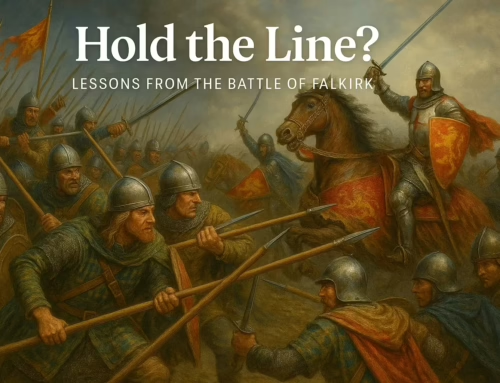On this day, centuries ago, muddy fields in northern France bore witness to one of the most iconic battles in military history – the Battle of Agincourt. While it occurred on October 25, 1415, its lessons are as resonant today as the resounding clang of a longbow arrow against a French knight’s armour.
King Henry V of England led an army estimated to be between 6,000 and 9,000 strong, with most being archers equipped with the famed English longbow. Facing them was a more significant French force, estimated to be anywhere from 12,000 to 36,000, predominantly comprised of heavy cavalry and armoured knights. The battle, fought during the Hundred Years’ War, was a true test of technology, tactics, and tenacity.
The English longbow was not merely a weapon but a marvel of medieval technology. It equalised the battlefield with a range exceeding 250 yards, and the ability to penetrate plate armour at close distances. At Agincourt, the longbow was the great leveller. The French knights, encased in armour and pride, advanced through the muddy fields only to be met with a rain of arrows. This deadly hailstorm decimated the French and rendered their numerical advantage moot.
Interesting Fact: A skilled English archer could release 10-12 arrows per minute, creating a relentless barrage that few armies of the era could withstand.
Agincourt wasn’t just a showcase of technology but a masterclass in using terrain and tactics. The narrow battlefield was flanked by dense woodland, constraining the movement of the French and funnelling them into the deadly path of English arrows. The muddy ground, a result of recent rains, hindered their cavalry charges. As the French bogged down and packed together, they became easier targets for the English archers.
What lessons does Agincourt offer to the modern military mind? Primarily, it underscores the importance of technological advantage and adaptability. In a contemporary setting, we see this reflected in the ongoing race for cyber warfare capabilities, drone technology, and advanced AI. Just as the longbow neutralised the armoured knight, modern technologies can nullify traditional military assets.
Training modern troops also means emphasising adaptability to unpredictable situations and terrains, just as the English exploited the muddy fields and woods. Today’s military academies stress the importance of understanding and leveraging the environment, whether in urban warfare or rugged mountain terrains.
The Battle of Agincourt, though fought with arrows and armour, offers lessons that are relevant in an era of missiles and cyber warfare. When adeptly used with the advantage of terrain and tactics, technology can tilt the odds even when faced with overwhelming numbers. As we remember this day, let it be a testament to the ever-evolving nature of warfare and the constant need for adaptability, foresight, and innovation.
Beyond the chronicles of historians, the Battle of Agincourt was immortalised by none other than the bard himself, William Shakespeare, in his play “Henry V.” This dramatic retelling not only captures the spirit and intensity of the battle but also delves into the character of King Henry, portraying him as a charismatic and inspirational leader. In this play, the famous St. Crispin’s Day Speech is found, where King Henry rallies his outnumbered troops with stirring words that have since echoed through the annals of time. The phrase “We few, we happy few, we band of brothers” encapsulates the camaraderie of soldiers on the eve of battle, a sentiment that resonates with warriors of any era. Shakespeare’s portrayal of Agincourt reminds us that beyond tactics and technology, the human spirit and the bonds forged in the crucible of combat often determine the tide of battle.




